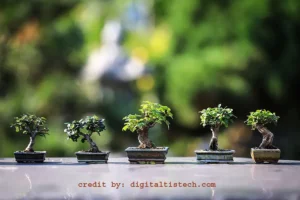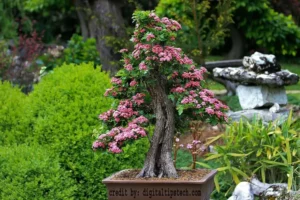If you’ve embarked on the rewarding journey of nurturing a juniper bonsai tree, you’re already familiar with its captivating beauty and the artistry involved in its care. One of the crucial aspects of maintaining a healthy and aesthetically pleasing juniper bonsai is knowing when and how to prune it. Pruning plays a pivotal role in shaping the tree, promoting growth, and ensuring its long-term vitality. In this guide, we’ll explore the ins and outs of juniper bonsai pruning, from understanding the best timing to the step-by-step process. Let’s dive in!

Bonsai cultivation is an art form that requires patience, dedication, and knowledge. Pruning, an essential practice in bonsai care, involves removing specific branches to achieve the desired shape and enhance the tree’s health.
Why Pruning Matters
Pruning serves several vital purposes in the development of a juniper bonsai. It stimulates new growth, maintains the tree’s size, and increases its overall aesthetic appeal. By removing certain branches, you enable the tree to allocate more energy to the remaining branches, leading to improved foliage density.
Understanding Juniper Bonsai
Juniper bonsai, with its intricate branches and needle-like leaves, requires thoughtful attention. There are various juniper species, each with its unique characteristics. Understanding your specific juniper’s growth pattern and natural tendencies is crucial before pruning.
The Best Time to Prune
Timing is everything when it comes to juniper bonsai pruning. The best times are during the late winter or early spring, just before the tree enters its growing season. This dormant period allows the tree to recover swiftly from pruning wounds.
Tools You’ll Need
Pruning successfully requires the proper equipment, which you should have on hand. Concave cutters, knob cutters, shears, and wire cutters are a few of these. Every instrument, from branch trimming to wiring, has a specific use.
Process for Pruning in Steps
Assessing the Tree’s Health
Before pruning, evaluate the juniper bonsai’s overall health. Remove any dead or diseased branches to prevent further complications.
Selecting Branches for Pruning
Identify the branches that disrupt the tree’s desired design. Focus on eliminating branches that cross each other, grow downward, or deviate from the intended shape.
Trimming Techniques
Use sharp shears to trim the selected branches. Employ clean cuts to minimize damage and promote faster healing.
Dealing with Deadwood
Juniper bonsai often features deadwood, which adds character to the tree. Carve and treat deadwood to prevent decay and ensure it blends harmoniously with the living parts.

Wiring for Shape
Wiring is a technique that guides branches into specific positions. Carefully wrap wire around branches, allowing you to bend and shape them as they grow.
Avoiding Common Mistakes
Over-Pruning
Pruning a tree too much might weaken it and impede its growth. Stick to the 20-30% rule: avoid removing more than a third of the foliage in one session.
Incorrect Timing
Pruning at the wrong time can stress the tree and hamper its recovery. Stick to the recommended late winter or early spring timeframe.
Neglecting Tools Maintenance
Dull or dirty tools can damage the tree and introduce disease. Regularly clean and sharpen your tools to ensure clean cuts and minimize harm.
Post-Pruning Care
After pruning, provide your juniper bonsai with proper care. Place it in a sheltered area with indirect sunlight to aid recovery.
Benefits of Regular Pruning
Regular pruning fosters the bonsai’s health and appearance. It encourages strong growth, maintains shape, and prevents overcrowding of branches.
What are the rules for pruning bonsai trees?
Pruning bonsai trees is a delicate and intricate process that involves carefully trimming and shaping the tree to maintain its miniature size and artistic form. Here are some general guidelines for pruning bonsai trees:
Know Your Bonsai Species
The needs and growth patterns of various tree species vary. To learn about the natural growth patterns and pruning tolerance of the bonsai tree variety you have chosen, do some research.
Tools
Use sharp and clean bonsai pruning tools such as concave cutters, pruning shears, and wire cutters. Utilizing clean instruments can help stop the spread of disease.
Timing
Prune your bonsai during the appropriate seasons. Generally, spring and early summer are good times for major pruning, while light trimming and maintenance can be done throughout the growing season. Avoid pruning during the winter dormant season.
Purpose of Pruning
Maintenance Pruning
Regularly remove dead, weak, and crossing branches to improve the overall health and appearance of the tree.
Structural Pruning
Shape the bonsai by removing or trimming branches to create the desired design or form. This includes defining the tree’s trunk line, branches, and foliage pads.

Branch Selection
Identify the branches that contribute to the overall design and style of the bonsai. Choose branches that are well-placed and complement the tree’s form.
Branch Angle and Direction
Pay attention to the angles and directions of branches. Maintain a balanced distribution of branches around the trunk, avoiding overly crowded areas.
Cutting Technique
Clean Cuts: Use sharp tools to make clean cuts that heal quickly and reduce the risk of infection. Cut at a slight angle to prevent water from accumulating on the wound.
Pruning above a Bud
When cutting a branch, make the cut just above a healthy bud or lateral shoot. This helps encourage new growth in the desired direction.
Wiring
Wiring is sometimes used to bend branches and shape the bonsai. Be careful not to wire too tightly, as it can damage the bark and inhibit the flow of sap. Before the wire begins to slash into the bark, remove it.
Consider Apical Dominance
The topmost bud or branch usually grows more vigorously than others. Trim the top to encourage lateral growth and balance.
Balance Growth
Prune the top and bottom of the tree to balance its growth. If the top is too vigorous, it can overshadow the lower branches, and vice versa.
Step-by-Step Approach
When making major changes, prune and style gradually over several seasons. Abrupt pruning can shock the tree and negatively impact its health.
Evaluate After Pruning
Step back and assess your work after each pruning session. This helps you make adjustments and refine the bonsai’s design over time.
Frequent Maintenance
Bonsai trees require ongoing care. Regularly inspect and prune to maintain the desired shape and health.
Should you pinch or cut juniper bonsai?
When caring for a juniper bonsai, both pinching and cutting techniques are essential, but they serve different purposes and are used at different times.
Pinching
Pinching involves removing the tender growth tips of the branches using your fingers or bonsai scissors. This technique is usually applied during the growing season (spring to early summer) to maintain the shape and density of the foliage. Pinching helps in promoting ramification, which means encouraging the growth of smaller branches and foliage closer to the trunk. It also helps prevent the bonsai from becoming too leggy.
Cutting
Cutting refers to more substantial pruning, where you remove entire branches or larger sections of growth. This is typically done during the dormant season (late autumn to winter) when the tree is not actively growing. Cutting is used to reshape the tree, remove unwanted branches, and maintain the overall design of the bonsai. It’s also a way to control the size and structure of the tree.
Both pinching and cutting are important techniques for maintaining the health and appearance of a juniper bonsai. Pinching is for refining the foliage and encouraging branching, while cutting is for more significant pruning and shaping. The timing of these techniques is crucial, so make sure to perform them at the appropriate seasons to achieve the best results.
FAQs
Can I prune my juniper bonsai in summer?
– Pruning during summer can stress the tree and impede growth. Stick to late winter or early spring for optimal results.
Is wiring necessary after every pruning session?
– Wiring is only necessary if you want to reshape or guide branches. Not every pruning session requires wiring.
Can I use regular scissors for pruning my juniper bonsai?
– It’s recommended to use bonsai-specific tools like shears and concave cutters for clean and precise cuts.
What if I prune more than the recommended 20-30% foliage?
– Excessive pruning can weaken the tree and slow its growth. Stick to the suggested limits to maintain the tree’s health.
How often should I prune my juniper bonsai?
– Juniper bonsai can be pruned once or twice a year, usually during the late winter or early spring dormant period.
Natural Quote:
Pruning a juniper bonsai tree is a skill that marries horticultural knowledge with artistic finesse. By following proper timing, techniques, and care, you’ll ensure the well-being and allure of your bonsai masterpiece.